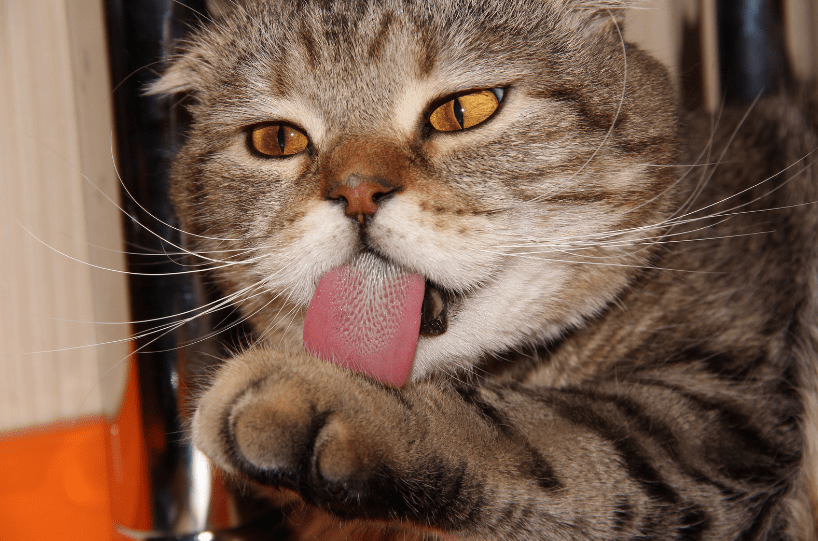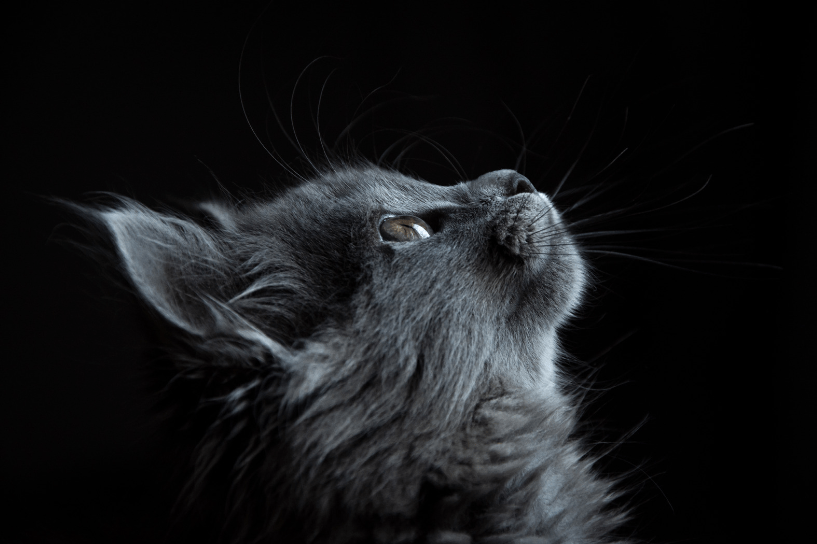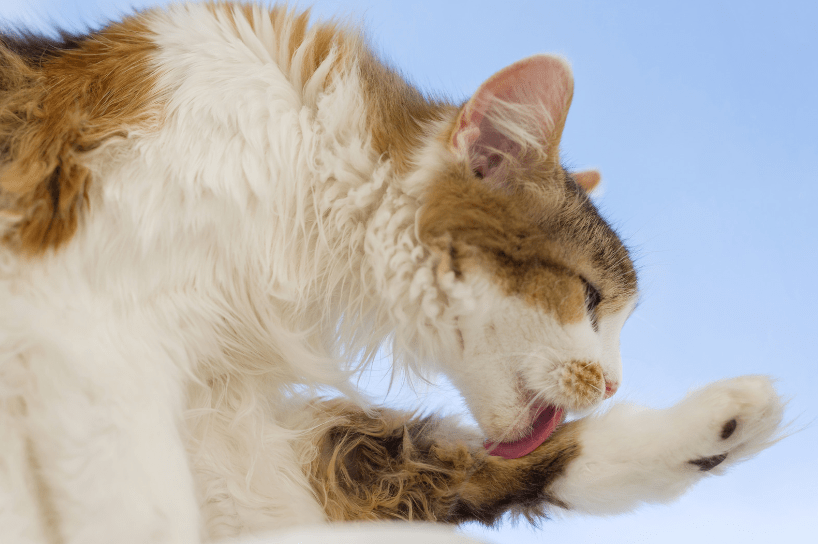Why is My Cat Pulling Her Hair Out? Your cat may be pulling her hair out due to stress, allergies, or skin conditions. Parasitic infestations like fleas could also be the cause.
Cats are meticulous groomers and any disruption in their routine can signal an underlying health issue. Stress, parasites, skin disorders, and even psychological conditions can lead to a behavior known as over-grooming or psychogenic alopecia, where a cat excessively licks or pulls out fur.
This self-inflicted hair loss can result from environmental changes, allergies, or boredom, making it important for cat owners to observe their pets for any signs of distress or discomfort. Quick identification and veterinary consultation are crucial in addressing this furry predicament. By keeping an eye out for such behavior and providing a nurturing environment, cat parents can help ensure their feline companions remain both happy and healthy.
Feline Stress And Hair Pulling: A Visible Symptom
Observing a cat in distress can be worrying for any pet owner. One such distressing behavior is hair pulling, a clear sign that something isn’t quite right. Understanding the reasons behind this can shed light on your feline friend’s mental health and help you find remedies.
Signs Of Stress In Cats
Cats are creatures of habit and comfort. Stress can manifest in various ways that are important to recognize:
- Behavior changes: Is your cat hiding more or acting differently?
- Appetite: Look out for changes in eating habits.
- Litter box issues: Unexpected accidents may indicate stress.
- Excessive grooming: It might point to anxiety.
- Vocalization: More meowing or growling than usual could be a sign.
Hair Pulling: When Grooming Turns Destructive
Cats normally
groom to keep clean. But sometimes, grooming can become harmful. This is known as psychogenic alopecia.
Watch for:
- Bald patches.
- Frequent licking or chewing of fur.
- Sores on the skin from over-grooming.
Understanding these issues is the first step toward helping your cat. Reducing stressors and creating a calm environment can do wonders. Consulting a vet is equally crucial to rule out medical concerns and to confirm if stress is the true cause.
Medical Reasons Behind Your Cat’s Behavior
Seeing a cat pulling out their hair can be alarming. It often points to underlying health matters. Cats are known for their grooming habits. Excessive grooming, however, can signal issues beyond normal routines. Here, we delve into medical reasons for such behavior.
Common Skin Conditions In Cats
Cats suffer from a variety of skin troubles. These can provoke itching, irritation, and hair-pulling. Listed below are frequent skin ailments in felines:
- Fleas: Parasites that cause severe itching and discomfort.
- Allergies: Allergic reactions to food, pollen, or household items can induce skin inflammation.
- Infections: Bacterial or fungal infections create sore, itchy spots.
- Mites: Tiny pests triggering mange, leading to skin issues and hair loss.
Internal Health Issues Leading To Excessive Grooming
Internal health woes might cause a cat to groom excessively. This table highlights common internal concerns:
| Internal Health Issue |
Impact on Behavior |
| Stress or Anxiety |
Oftentimes leads to over-grooming as a coping mechanism. |
| Thyroid Problems |
Hyperthyroidism can increase grooming habits. |
| Pain |
Pain, especially from conditions like arthritis, may cause focused grooming on sore spots. |
| Neurological Disorders |
Can lead to compulsive grooming behaviors. |
Should you notice hair-pulling behavior in your cat,
consult your vet. Early detection can make a significant difference in treatment.

Psychological Triggers For Hair Pulling In Cats
First, it’s important to understand that cats, like humans, can experience stress and anxiety. Just as humans might bite their nails or pull their hair in response to stress, cats may engage in similar behaviors. Some common stressors for cats include changes in their environment, such as moving to a new home or the introduction of a new pet. Additionally, cats may experience anxiety due to illness, boredom, or even changes in their routine.
Furthermore, it’s essential to consider any recent changes in your cat’s life that may be contributing to her distress. For example, has there been a change in your household, such as a new family member or a change in routine? Understanding the potential triggers for your cat’s distress can help address the underlying cause of her hair-pulling behavior.
In addition to environmental stressors, it’s also important to consider any underlying medical conditions that could be causing your cat’s hair-pulling behavior. Skin conditions, allergies, or parasites could be contributing to your cat’s discomfort, leading her to pull out her hair as a way to alleviate her symptoms. It’s crucial to consult with a veterinarian to rule out any potential medical causes for your cat’s behavior.
Anxiety And Environmental Factors
Cats are sensitive creatures. Changes in their environment can trigger stress. Look out for these signs:
- New pets or people in the home
- Changes in routine or living situations
- Noisy or chaotic environments
Any change can make your cat feel anxious. They may start pulling their hair out as a way to cope.
The Impact Of Boredom And Lack Of Stimulation
Boredom isn’t just a human issue. Cats need stimulation to stay happy. Without it, they may start self-destructive behaviors like hair-pulling. Here’s how you can help:
- Offer various toys to play with
- Setup perches or cat trees for climbing
- Consider getting a feline friend if you’re often away
Engagement is key to a stimulated and healthy kitty.
The Influence Of Diet On Your Cat’s Skin And Coat
The link between diet and your cat’s skin and coat health is not always obvious, but it plays a significant role in their overall well-being. One common issue that can arise from a poor diet is overgrooming, where cats pull out their fur. This behavior can be puzzling, but it often indicates an underlying nutritional imbalance. It’s important to recognize that a lack of essential nutrients can lead to various health issues, including skin and coat problems. By understanding the impact of diet on these conditions, you can take proactive steps to ensure your cat’s comfort and health.
Nutritional Deficiencies And Overgrooming
Nutritional deficiencies can directly affect your cat’s skin and coat. Essential nutrients like omega-3 fatty acids, vitamins, minerals, and protein support skin health. A lack of these can lead to dry skin, irritation, and excessive grooming. This excessive grooming might cause hair loss. Cats sometimes pull their hair out as a response to the discomfort they feel.
- Omega-3 fatty acids reduce inflammation and keep skin hydrated.
- Vitamins A and E support skin cell regeneration and heal damaged skin.
- Zinc is crucial for maintaining skin structure and function.
- Protein supplies the building blocks for a healthy coat and skin.
Choosing The Right Diet For Skin Health
Choosing the right diet is key to preventing and treating skin issues. This includes overgrooming. The best diet for your cat should contain all vital nutrients. It should promote a healthy skin and coat. Here are the options to consider:
| Nutrient |
Food Source |
Benefits |
| Omega-3s |
Fish oil, flaxseed |
Moisturizes skin, reduces inflammation |
| Vitamins A & E |
Liver, leafy greens |
Repairs skin, boosts immunity |
| Zinc |
Meat, pumpkin seeds |
Strengthens skin structure |
| Protein |
Chicken, turkey, eggs |
Builds hair and skin cells |
Consult your veterinarian to tailor your cat’s diet. They can suggest changes that address any deficiencies. They can also recommend high-quality commercial cat foods. These foods specifically target skin and coat health. Or, they can confirm if a special diet is needed. Your cat’s shiny coat and comfortable skin is a signs of good inner health. It is achievable with the right nutritional balance!

Identifying Allergies As Culprits
Identifying Allergies as Culprits for your cat’s distressing behavior of pulling out her hair can be challenging. Cats are notoriously good at hiding their discomfort, but allergy issues can cause them significant irritation. Understanding and identifying potential allergens is key to providing relief for your feline friend. Let’s explore the common substances that could be triggering your cat’s allergies.
Common Allergens In Feline Life
Felines may encounter various allergens in their daily life. These can cause allergic reactions, often leading to skin issues like hair pulling. Common allergens include:
- Flea bites: Even a single flea bite can trigger an allergic response in cats.
- Dust mites: These tiny creatures can be found in homes, causing allergic reactions.
- Pollen: Cats can be allergic to tree, weed, or grass pollen, just like humans.
- Mold spores: Molds in damp areas can contribute to feline allergies.
- Food ingredients: Certain cat foods with specific proteins or additives can cause allergic reactions.
- Household cleaners: Strong chemicals in cleaners can irritate a cat’s skin.
Diagnosing And Managing Cat Allergies
Diagnosing cat allergies often starts with a visit to the vet. They may suggest:
- Elimination diets to pinpoint food allergies.
- Special shampoos to relieve skin irritation.
- Medications to control symptoms.
- Blood or skin tests to detect environmental allergens.
Management strategies for cat allergies typically involve:
- Avoiding known allergens as much as possible.
- Regularly cleaning the living environment to minimize allergens.
- Administering prescribed allergy treatments consistently.
- Using hypoallergenic bedding and grooming products.
Remember that patience and consistent care are vital to helping your cat live comfortably with allergies. Work closely with your vet to find the best plan for your cat.
The Role Of Parasites In Compulsive Grooming
The sight of your cat pulling her hair out can be concerning. Often overlooked, parasites play a substantial role in your cat’s compulsive grooming habits. Let’s dive into how these tiny pests can trigger significant distress for your furry friend.
Fleas, Mites, And Ticks: Tiny Causes Of Big Problems
Cats are meticulous creatures, known for their constant grooming. When this turns into hair-pulling, look out for the little culprits. Fleas can trigger allergic reactions, resulting in a condition known as flea allergy dermatitis. This causes intense itching, prompting your cat to pull out hair.
- Mites can lead to scabies or ear mites, causing extreme discomfort.
- Ticks latch onto the skin, leading to irritation that can cause your cat to overgroom.
Effective Parasite Control Measures
To protect your cat from these pesky parasites, an effective control strategy is crucial. Start with regular veterinary check-ups to catch infestations early. Your vet can recommend topical treatments or oral medications to keep parasites at bay.
- Regularly wash your cat’s bedding.
- Maintain a clean indoor environment to reduce the risk of infestation.
- Use approved flea collars or spot-on treatments as preventative measures.
Behavioral Modification Techniques To Reduce Stress
If you’ve noticed your cat pulling out her hair, it’s important to address the root cause. Stress in felines often leads to this behavior. Implementing behavioral modification techniques can make a world of difference. Let’s explore practical strategies to create a calm environment for your kitty.
Environmental Enrichment Strategies
Creating a stimulating environment is key to your cat’s well-being. Use these tips:
- Provide Climbing Opportunities: Install shelves or cat trees.
- Interactive Toys: Puzzle feeders and laser pointers keep them busy.
- Window Access: A perch by the window offers hours of entertainment.
- Safe Outdoor Enclosures: A ‘catio’ can stimulate their senses safely.
These adjustments promote exercise and mental stimulation, reducing hair-pulling behavior.
Training And Habit-reversal Therapies
Behavioral training can help cats overcome stress-related habits:
- Clicker Training: This reinforces positive behavior with clicks and treats.
- Designated Scratch Posts: Redirect scratching tendencies to appropriate areas.
- Regular Playtime: Schedule daily sessions to strengthen your bond.
Consistency with these therapies encourages better behavior and deters harmful habits. Alongside these techniques, regular checkups with your vet ensure your cat’s health stays on track. A stress-free cat means a happy home for everyone!

When To Consult A Veterinarian
Seeing your cat pulling out her hair can be alarming. Bald patches or visible thinning in your cat’s coat calls for professional advice. It’s crucial to recognize when a trip to the vet is necessary. Sudden changes in behavior, persistent scratching, or signs of skin irritations are red flags. Sudden weight loss, changes in appetite, or a shift in your cat’s mood can accompany these physical symptoms. In these instances, immediate veterinary attention can prevent more serious health concerns.
What To Expect During The Examination
A thorough veterinary examination can pinpoint the cause of your cat’s distress. The vet will look for skin conditions, parasites, allergies, and signs of infections. Your cat’s overall health, diet, and environment will also be assessed. A series of tests, such as blood work or a skin scrape, may be performed. Accurate diagnosis is crucial for the right treatment plan.
The Importance Of Timely Medical Intervention
Postponing a vet visit could worsen your cat’s condition. Early intervention often results in a quicker recovery. Conditions like allergies or hormonal imbalances require quick action. Left untreated, simple issues can lead to complications. Regular veterinary checks help maintain your cat’s well-being. Proactive care prolongs a healthy life.
Integrative Approaches: Combining Conventional And Alternative Therapies
Integrative veterinary care provides a holistic approach to addressing a cat’s hair-pulling behavior. This method takes into consideration the physical, emotional, and environmental factors that may be contributing to the problem. By incorporating alternative treatments such as acupuncture, herbal medicine, and nutritional therapy, integrative veterinary care aims to address the root cause of hair-pulling behavior rather than just treating the symptoms. This approach can provide a more well-rounded and personalized treatment plan for your cat, ultimately leading to a better quality of life for your feline companion.
The Benefits Of Acupuncture And Aromatherapy
Acupuncture has a storied history of alleviating various ailments. For cats, this could translate to less anxiety and a calmer disposition. Tiny needles stimulate your cat’s body, promoting healing and pain relief.
Aromatherapy uses natural oils to soothe your cat’s senses. Essential oils such as lavender can create a tranquil atmosphere. Always use feline-safe products and consult with a vet before starting.
- Stress Reduction: Both therapies can reduce anxiety.
- Pain Management: Acupuncture may help with skin discomfort.
- Safety: Aromatherapy offers a non-invasive alternative.
Herbal Remedies And Supplements For Stress Relief
Herbal treatments and supplements can be gentle on your cat’s system. Ingredients like chamomile or valerian root aid in relaxing nervous cats. They tackle the root cause of stress which may lead to hair pulling.
| Supplement |
Purpose |
Benefits |
| Omega-3 Fatty Acids |
Skin Health |
Promotes shiny coat, reduces irritation |
| B-Complex Vitamins |
Overall Health |
Supports the nervous system, reduces stress |
Note that professional guidance is crucial before administering any herbs or supplements. They ensure the right dosage and proper integration with your cat’s current health regime.
Real Stories: Owners And Their Troubled Cats
In the following stories, you will find a range of experiences and solutions that cat owners have explored when faced with the challenge of their cats pulling out their hair. From identifying triggers to finding effective treatments, these personal accounts offer valuable insights for anyone dealing with this perplexing issue. By learning from others who have walked this path, you can gain a deeper understanding of the complexities of feline hair-pulling and find hope in the success stories shared here.
Successful Management Case Studies
Lucy’s Victory Over Stress: Lucy, a Siamese mix, fought anxiety-induced over-grooming. Her owner introduced pheromone diffusers and play therapy. Regular check-ups confirmed Lucy’s steady improvement.
Max’s Triumph: Regrowth After Allergies: Dust mites triggered Max’s excessive grooming. His human switched to hypoallergenic bedding. Bi-monthly vet visits ensured Max’s skin healed and his hair regrew.
Shadow’s Comeback: Beating Boredom: An indoor Tabby, Shadow, pulled his hair out from ennui. Interactive toys and climbing structures added excitement to Shadow’s routine. He soon rediscovered his zest for life.
Bella’s Relief: Dietary Changes That Helped: Trial and error led Bella’s owner to identify a food allergy. A diet overhaul with guidance from a vet nutritionist turned Bella’s life around. Her coat became lush once more.
Lessons Learned And Tips For Fellow Cat Owners
Understanding the why is crucial. Is it boredom, stress, allergies, or parasites? Observation and veterinary advice are your best tools.
- Maintain a calm environment for stress-prone cats.
- Investigate potential allergens in your cat’s surroundings.
- Regular vet visits catch issues before they escalate.
- Keep your cat engaged—mental stimulation is key.
- Monitor your cat’s diet for any adverse reactions.
Every cat is unique; what works for one may not work for another. Patience, experimentation, and professional support pave the way to a solution. Your furry friend can conquer this challenge, and so can you.
Conclusion
Understanding your cat’s behavior is crucial for her well-being. If she’s pulling hair out, act promptly. Consult a vet to rule out health issues and consider environmental stressors. Remember, a stress-free home and good health are the keys to preventing such behaviors.
Keep your beloved feline happy and healthy.










